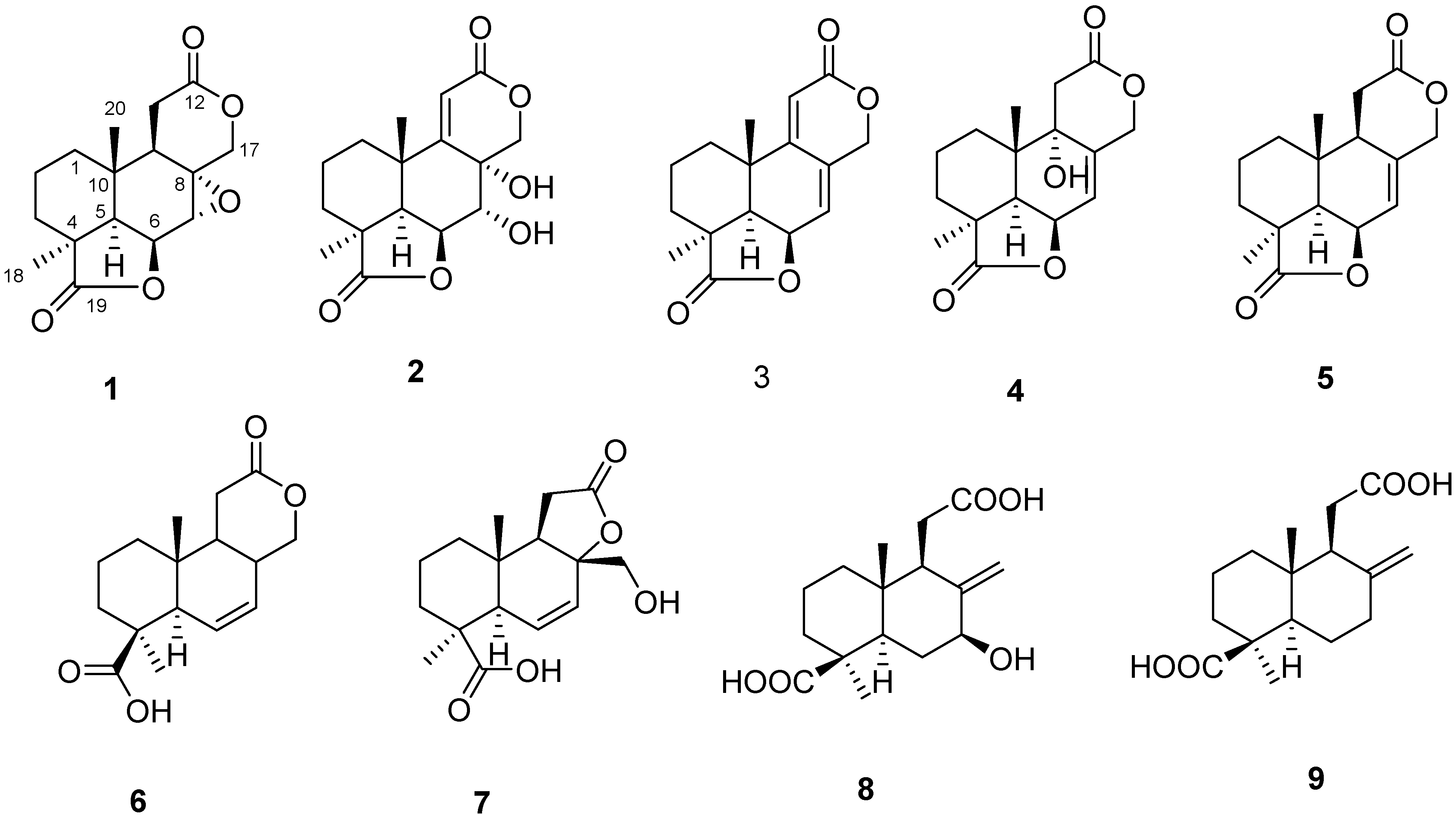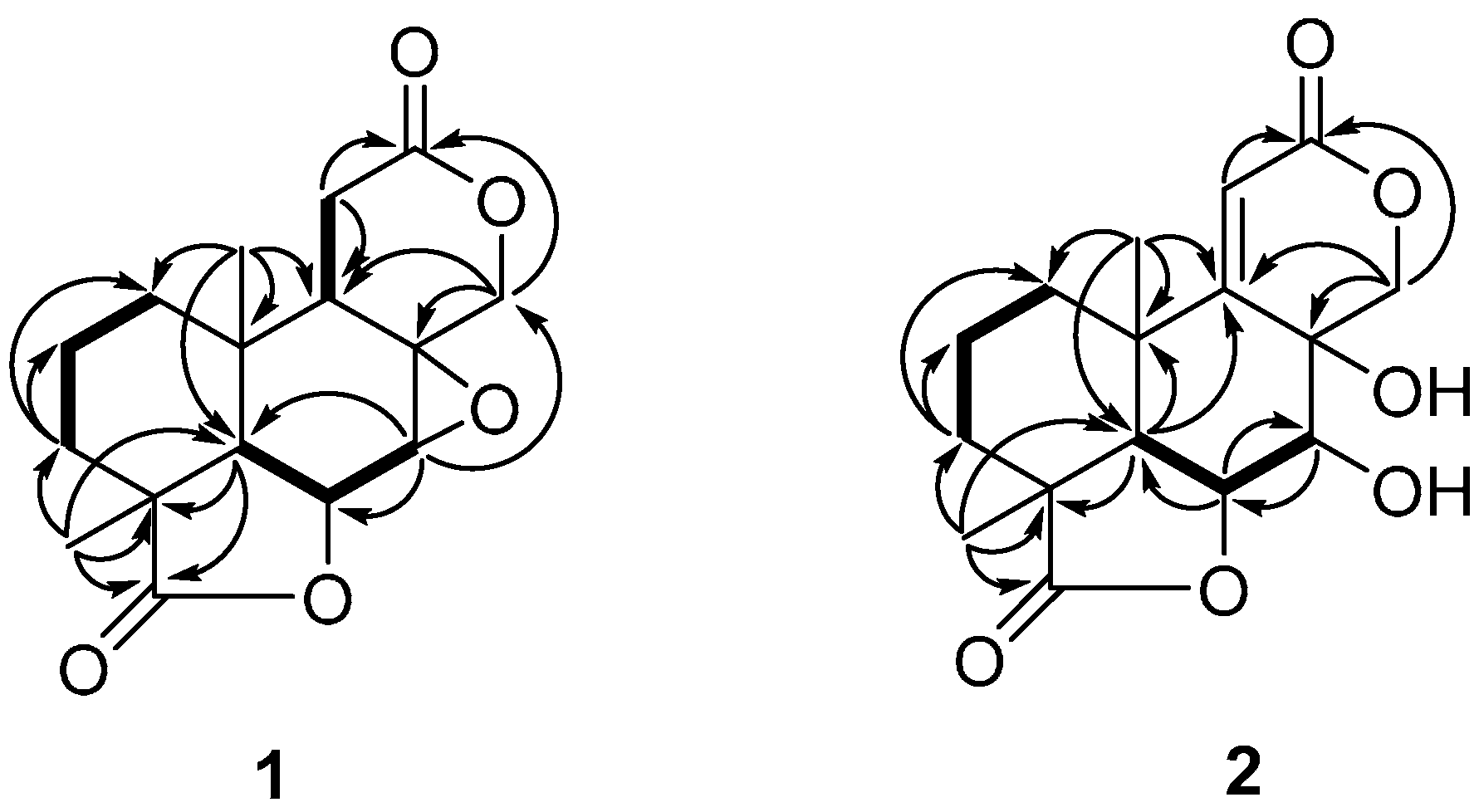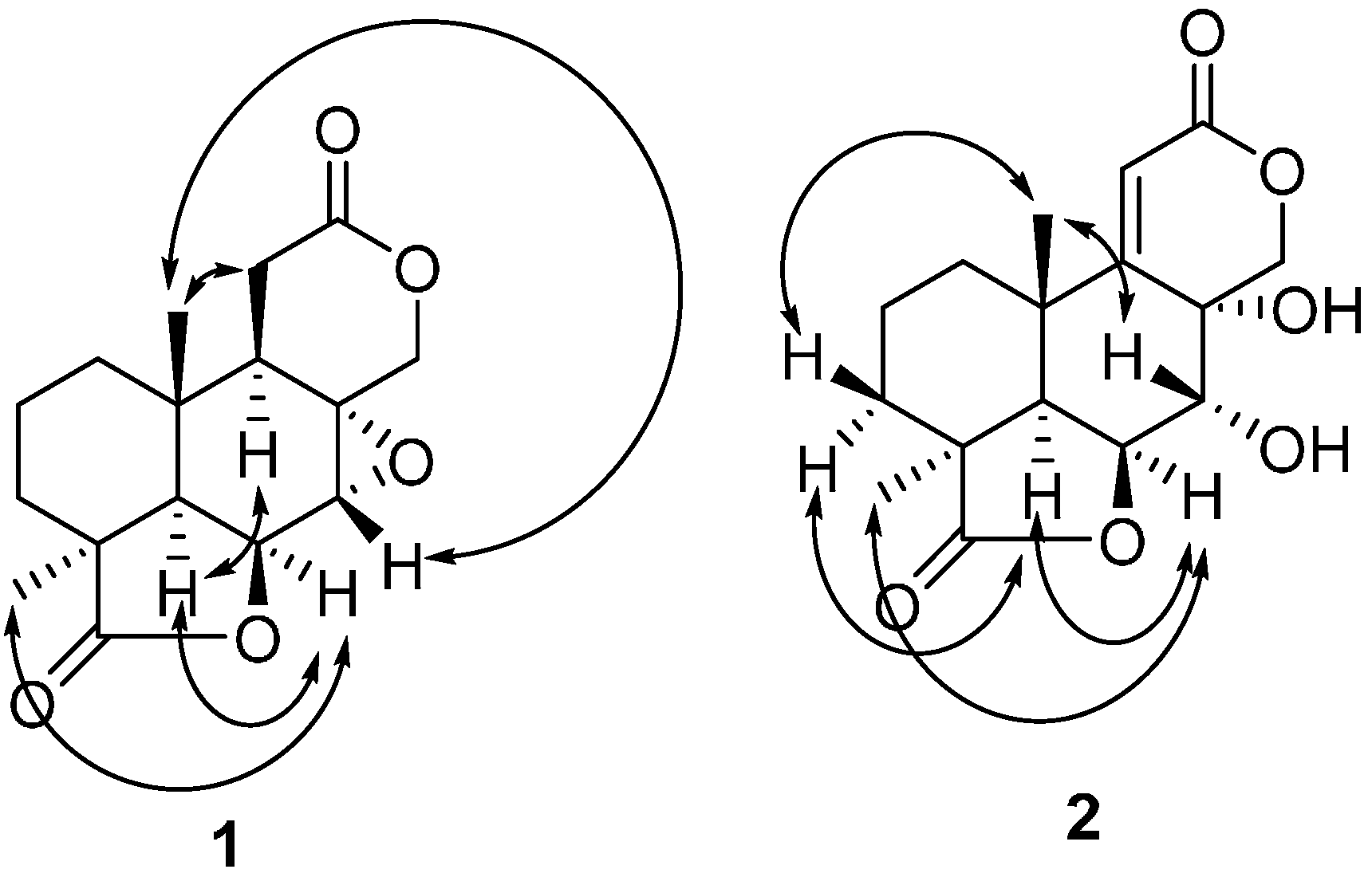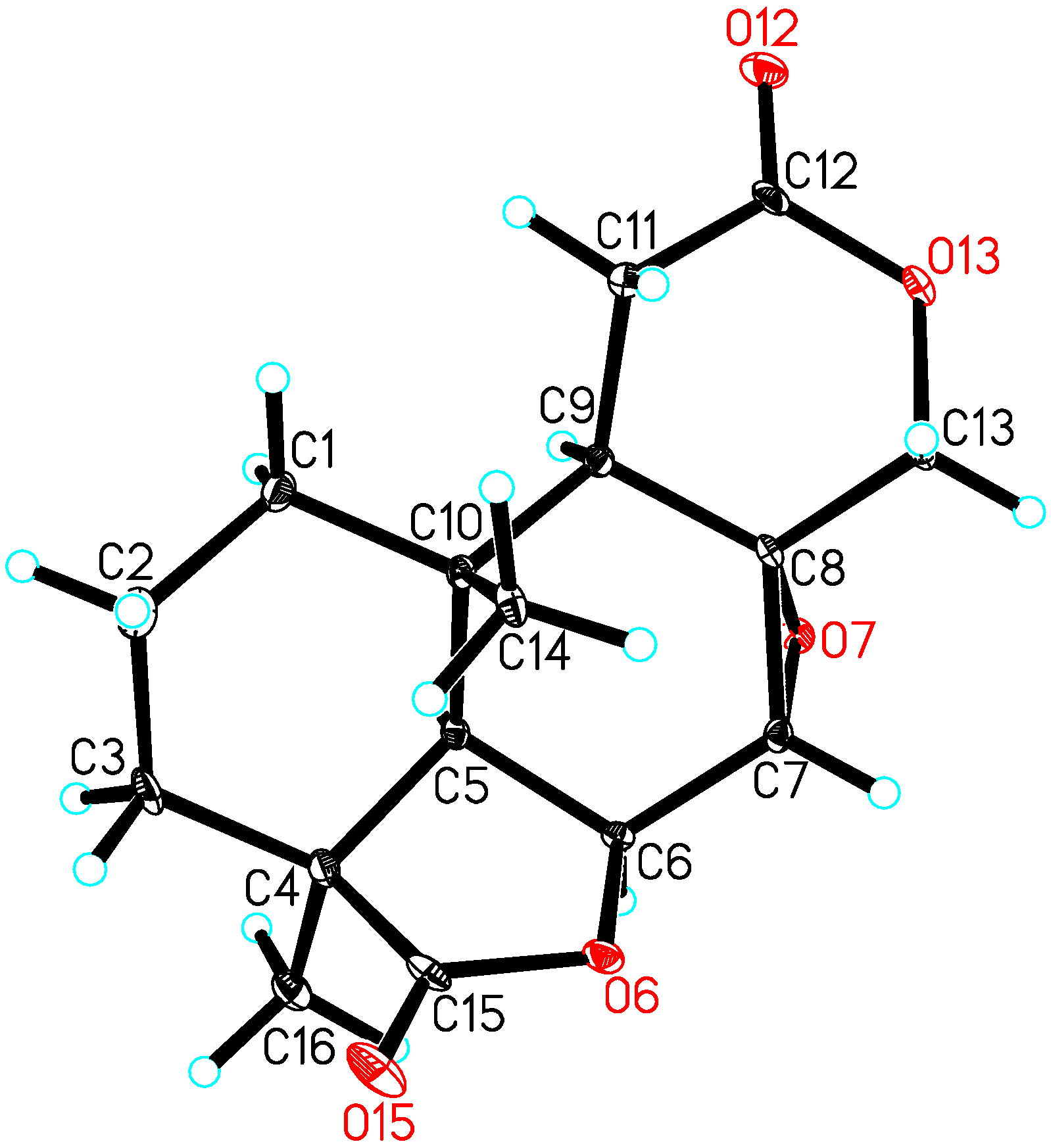Diterpenoids from the Endophytic Fungus Botryosphaeria sp. P483 of the Chinese Herbal Medicine Huperzia serrata
Abstract
:1. Introduction

2. Results and Discussion
2.1. Characterization



| Position | 1 a | 2 b | ||||
|---|---|---|---|---|---|---|
| δH (multi, J in Hz) | δC | HMBC | δH (multi, J in Hz) | δC | HMBC | |
| 1β | 1.54, m | 32.0 | 3, 10 | 1.76, m | 33.9 | 2, 3, 5, 9, 10, 20 |
| 1α | 1.15, m | 3, 9, 10 | 1.48, m | 2, 3, 10, 20 | ||
| 2β | 1.65, m | 17.5 | 1, 3, 4 | 1.60, m | 17.7 | 2, 4, 10 |
| 2α | 1.59, m | 1, 3, 4 | 1.43, m | 1, 3 | ||
| 3β | 2.21, dt, 14.4, 5.3 | 28.51 | 1, 4, 5, 18, 19, 20 | 2.21, m | 27.8 | 1, 2, 4, 5, 18, 19 |
| 3α | 1.49, m | 1, 4, 5, 18, 19, 20 | 1.35, m | 1, 2, 4, 5, 18, 19 | ||
| 4 | - | 41.7 | - | - | 42.1 | - |
| 5 | 1.67, d, 4.7 | 49.2 | 1, 4, 10, 18, 19, 20 | 2.86, d, 5.5 | 47.0 | 1, 3, 4, 9, 10, 18, 19, 20 |
| 6 | 4.90, d, 4.7 | 72.4 | 7, 8, 10 | 5.40, t, 5.5 | 84.0 | 4, 7, 10 |
| 7 | 3.56, brs | 53.6 | 5, 6, 17 | 4.73, d, 5.5 | 71.8 | 6, 17 |
| 8 | - | 60.6 | - | - | 68.5 | - |
| 9 | 1.90, dd, 6.4, 11.4 | 43.2 | 5, 8, 10, 11, 12, 20 | - | 168.0 | - |
| 10 | - | 34.0 | - | - | 35.7 | - |
| 11α | 2.70, dd, 6.4, 15.2 | 28.45 | 8, 9, 10, 12 | 6.11, s | 114.9 | 8, 9, 10, 12, 20 |
| 11β | 2.54, dd, 11.4, 15.2 | 8, 9, 10, 12 | ||||
| 12 | - | 171.6 | - | - | 164.7 | - |
| 17β | 4.41, d, 12.8 | 71.2 | 7, 8, 9, 12 | 5.18, d, 11.9 | 75.7 | 8, 9, 10 |
| 17α | 4.05, d, 12.8 | 7, 8, 9, 12 | 4.62, d, 11.9 | 8 | ||
| 18 | 1.28, s | 24.4 | 3, 4, 5, 19 | 1.19, s | 24.4 | 4, 5, 19, 20 |
| 19 | - | 180.4 | - | - | 182.2 | - |
| 20 | 0.93, s | 17.6 | 1, 5, 9, 10, | 1.20, s | 27.7 | 1, 5, 9, 10 |
2.2. Biological Activities
| Compounds | Diameter of Fungus-Free Zone (mm) | ||||
|---|---|---|---|---|---|
| G. graminis | F. solani | P. oryzae | F. moniliforme | F. oxysporum | |
| 2 | 9 | 7 | 7 | 8 | 8 |
| 3 | 12 | 10 | 10 | 11 | 13 |
| Carbendazim (50 μg/disk) | 14 | 18 | 15 | 17 | 15 |
| Control (methanol) | 0 | 0 | 0 | 0 | 0 |
3. Experimental Section
3.1. General
3.2. Fungal Material
3.3. Fermentation, Extraction and Isolation
3.4. Bioassays
4. Conclusions
Supplementary Materials
Acknowledgments
Author Contributions
Conflicts of Interest
References
- Hyde, K.D.; Soytong, K. The fungal endophyte dilemma. Fungal Divers. 2008, 33, 163–173. [Google Scholar]
- Tan, R.X.; Zou, W.X. Endophytes: A rich source of functional metabolites. Nat. Prod. Rep. 2001, 18, 448–459. [Google Scholar] [CrossRef] [PubMed]
- Gutierrez, R.M.; Gonzalez, A.M.; Ramirez, A.M. Compounds derived from endophytes: A review of phytochemistry and pharmacology. Curr. Med. Chem. 2012, 19, 2992–3030. [Google Scholar] [CrossRef] [PubMed]
- Kozikowski, A.P.; Tueckmantel, W. Chemistry, pharmacology, and clinical efficacy of the Chinese nootropic agent huperzine A. Acc. Chem. Res. 1999, 32, 641–650. [Google Scholar] [CrossRef]
- Zhao, P.J.; Fan, L.M.; Li, G.H.; Zhu, N.; Shen, Y.M. Antibacterial and antitumor macrolides from Streptomyces sp. Is9131. Arch. Pharm. Res. 2005, 28, 1228–1232. [Google Scholar] [CrossRef] [PubMed]
- Zhao, P.J.; Wang, H.X.; Li, G.H.; Li, H.D.; Liu, J.; Shen, Y.M. Secondary metabolites from endophytic Streptomyces sp. Lz531. Chem. Biodivers. 2007, 4, 899–904. [Google Scholar] [CrossRef] [PubMed]
- Yang, Y.H.; Fu, X.L.; Li, L.Q.; Zeng, Y.; Li, C.Y.; He, Y.N.; Zhao, P.J. Naphthomycins L-N, ansamycin antibiotics from Streptomyces sp. CS. J. Nat. Prod. 2012, 75, 1409–1413. [Google Scholar] [CrossRef] [PubMed]
- Barrero, A.F.; del Moral, J.F.Q.; Cuerva, J.M.; Cabrera, E.; Jimenez-Gonzalez, D. Preparation of bioactive podolactones via a new Pd-catalyzed bislactonisation reaction. Synthesis of oidiolactone C. Tetrahedron Lett. 2000, 41, 5203–5206. [Google Scholar] [CrossRef]
- Yuan, L.; Zhao, P.J.; Ma, J.; Lu, C.H.; Shen, Y.M. Labdane and tetranorlabdane diterpenoids from Botryosphaeria sp. MHF, an endophytic fungus of Maytenus hookeri. Helv. Chim. Acta 2009, 92, 1118–1124. [Google Scholar] [CrossRef]
- Pettit, G.R.; Tan, R.; Herald, D.L.; Hamblin, J.; Pettit, R.K. Antineoplastic agents. 488. isolation and structure of Yukonin from a yukon territory fungus. J. Nat. Prod. 2003, 66, 276–278. [Google Scholar] [CrossRef] [PubMed]
- Hosoe, T.; Nozawa, K.; Lumley, T.C.; Currah, R.S.; Fukushima, K.; Takizawa, K.; Miyaji, M.; Kawai, K. Tetranorditerpene lactones, potent antifungal antibiotics for human pathogenic yeasts, from a unique species of Oidiodendron. Chem. Pharm. Bull. 1999, 47, 1591–1597. [Google Scholar] [CrossRef] [PubMed]
- Flack, H.D.; Bernardinelli, G. The use of X-ray crystallography to determine absolute configuration. Chirality 2008, 20, 681–690. [Google Scholar] [CrossRef] [PubMed]
- Hooft, R.W.; Straver, L.H.; Spek, A.L. Determination of absolute structure using Bayesian statistics on Bijvoet differences. J. Appl. Crystallogr. 2008, 41, 96–103. [Google Scholar] [CrossRef] [PubMed]
- Espinel-Ingroff, A.; White, T.; Pfaller, M.A. Antifungal agents and susceptibility tests. In Manual of Clinical Microbiology, 7th ed.; Murray, P.R., Ed.; American Society for Microbiology: Washington, DC, USA, 1999; pp. 1640–1652. [Google Scholar]
- Li, G.H.; Duan, M.; Yu, Z.F.; Li, L.; Dong, J.Y.; Wang, X.B.; Guo, J.W.; Huang, R.; Wang, M.; Zhang, K.Q. Stereumin A–E, sesquiterpenoids from the fungus Stereum sp. CCTCC AF 207024. Phytochemistry 2008, 69, 1439–1445. [Google Scholar] [CrossRef] [PubMed]
- Sample Availability: Samples of the compounds 1–9 are available from the authors.
© 2015 by the authors. Licensee MDPI, Basel, Switzerland. This article is an open access article distributed under the terms and conditions of the Creative Commons Attribution license ( http://creativecommons.org/licenses/by/4.0/).
Share and Cite
Chen, Y.-M.; Yang, Y.-H.; Li, X.-N.; Zou, C.; Zhao, P.-J. Diterpenoids from the Endophytic Fungus Botryosphaeria sp. P483 of the Chinese Herbal Medicine Huperzia serrata. Molecules 2015, 20, 16924-16932. https://doi.org/10.3390/molecules200916924
Chen Y-M, Yang Y-H, Li X-N, Zou C, Zhao P-J. Diterpenoids from the Endophytic Fungus Botryosphaeria sp. P483 of the Chinese Herbal Medicine Huperzia serrata. Molecules. 2015; 20(9):16924-16932. https://doi.org/10.3390/molecules200916924
Chicago/Turabian StyleChen, Yan-Mei, Yin-He Yang, Xiao-Nian Li, Cheng Zou, and Pei-Ji Zhao. 2015. "Diterpenoids from the Endophytic Fungus Botryosphaeria sp. P483 of the Chinese Herbal Medicine Huperzia serrata" Molecules 20, no. 9: 16924-16932. https://doi.org/10.3390/molecules200916924





